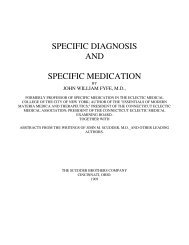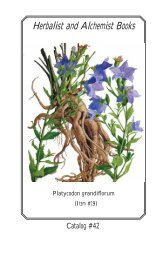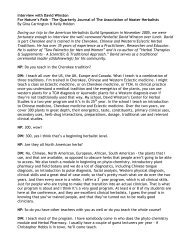MEDlCINAL PLANTS OF JAMAICA. PARTS 1 & 11.
MEDlCINAL PLANTS OF JAMAICA. PARTS 1 & 11.
MEDlCINAL PLANTS OF JAMAICA. PARTS 1 & 11.
Create successful ePaper yourself
Turn your PDF publications into a flip-book with our unique Google optimized e-Paper software.
CITRUS AURANTIUM L. Sweet Oranqe.<br />
C. VULGARIS Risso. Seville, Biller, Sour or Biqarade Oranqe.<br />
A decoction of orange leaves or peel is used for stomach-ache and as a bitter tonic. The juice of sour<br />
oranges is used for colds and sore throat. Leaves, twigs and fruit peel contain essential oil with d.limonene, dcamphene,<br />
l-linalol. geraniol, methyl anthranilate and citral.<br />
The glucoside hesperidin is found in leaves, peel and fruit juice; vitamins A, C and the B complex,<br />
together with, acids such as citric acid (and their salts) are present in the fruit juice. In Africa roasted orange is<br />
sometimes applied to ulcers and yaws. Bitter orange is thought to be a remedy for rheumatism. (3, IS, 26, 27).<br />
SAPINDACEAE<br />
About one thousand and fifty. mainly woody, species of warm regions. with widely distributed saponins<br />
and tannins. Of the alkaloids only caffeine is found.<br />
BLIGHIA SAPIDA Koenig. Akee.<br />
In some parts of Jamaica akee leaves are boiled to make a 'rub' for pains. In the Gold Coast of Africa the<br />
bark is ground up with Capsicum to rub on the body as a stimulant. It is also said that in Jamaica tea made with<br />
the leaves is used for colds. (7, 27).<br />
SAPOTACEAE<br />
Six hundred tropical woody species with latex canals in the leaves, bark and pith. Saponins, tannins,<br />
bitter principles and glucosides occur.<br />
SAPOTA ACHRAS Mill. Naseberry: Sapodilla.<br />
Browne reports that the bark of this and several other species was known as Cortex jamaicensis and was<br />
at one time used instead of cinchma. He was of the opinion, however, that while it is astringent it is of no use<br />
for malaria. The leaves are said to provide a nerve tonic. They contain a little alkaloid, one or more bitter<br />
principles, resins and tannic acid. The bark is reputed to contain an alkaloid 'sapotin' which, according to others,<br />
is a saponin, and various tannin compounds. (5, 14, 27).<br />
SIMARUBACEAE<br />
About one hundred and fifty species of woody plants with bitter bark and fatty seeds. Some glucosides,<br />
including cedrin. castelin, valdivin. are found; biller principles such as quassin and simarubin occur.<br />
PICRAENA EXCELSA Lindl. Jamaica Quassia: Bitter Wood; Bitter Ash.<br />
The wood provides the Jamaican Quassia of commerce. The bitter principle, thought at one time to be a<br />
mixture of substances called 'picrasmin', was later shown to be the single bitter quassin (C 20H 300 6). It is both a<br />
tonic and an insecticide. Quassia is used as a home remedy for threadworms in children, as a tonic and appetite<br />
stimulant, and for malaria. Cups hollowed out from pieces of the wood were, at one time, used to prepare the<br />
medicine. Water left to stand in the cup for even a short time becomes bitter. (8, 14, 19, 27).<br />
PICRAMNIA ANTIDESMA Sw. Maioe Bitters: Macary or Old Woman's Bitter; Tom Bontrin's<br />
Bush; Bitter Wood; Honduras Bark; Cascara Amarga.<br />
This plant is still in use in Jamaica for the preparation of home remedies. It is said to make a good tea<br />
for a teething baby. Barham says that the name 'Majoe' is that of an old negro woman who used the plant with<br />
considerable success in the treatment of yaws and venereal diseases. It has also been used for colic, intermittent<br />
fevers and skin ulcers. A Picramnia species is stated to have been introduced into medicine as Honduras Bark or<br />
Cascala Amarga (19). Macfayden mentions that the bitter is less intense than quassia. (8, 15, 19, 27).







